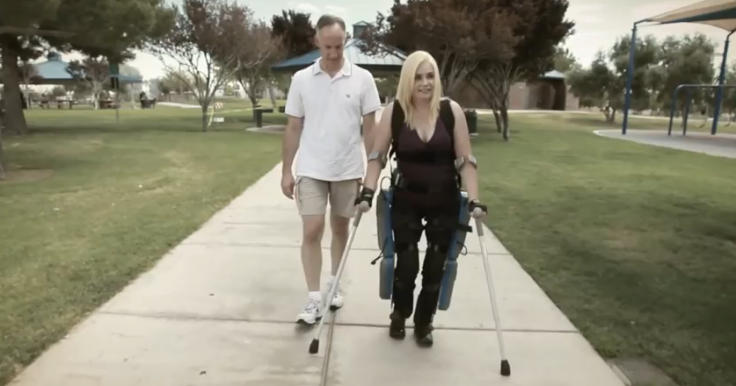FDA Approves 'ReWalk' Exoskeleton To Help Paraplegics Stand, Sit, And Walk

The inability to stand, sit, or walk on our own can render us disabled and heavily dependent on a caregiver to carry on with day-to-day activities. With the help of cutting-edge technology, scientists have revolutionized mobility for about 200,000 people in the U.S. living with a spinal injury, with “ReWalk,” the first FDA-approved motorized exoskeleton device. The wearable robotic legs will be exclusively available in the U.S. market for those whose lower body is paralyzed from a spinal cord injury.
The product, manufactured by Argo Medical Technologies of Marlborough, Mass., was developed by founder Dr. Amit Goffer in 2001 after he was left paralyzed in an accident with an all-terrain vehicle in 1997, according to the company’s statement. It was through his personal experience in using mobility devices that Goffer developed the ReWalk. It has been available in Europe since 2012.
“Innovative devices such as ReWalk go a long way towards helping individuals with spinal cord injuries gain some mobility,” said Christy Foreman, director of the Office of Device Evaluation, at the FDA’s Center for Devices and Radiological Health, in a FDA statement. “Along with physical therapy, training and assistance from a caregiver, these individuals may be able to use these devices to walk again in their homes and in their communities.”
ReWalk costs $69,500 and consists of a fitted, metal brace that supports the legs and part of the upper body; small motors that supply movement at the hips, knees, and ankles; a tilt senor, and a backpack that contains the computer and power supply. The device can be operated with a wireless remote control on the wrist. If necessary, crutches help the user with additional stability. Although it weighs 46 pounds, the user will only feel 5 pounds, which comes from carrying the backpack.
Traumatic injury to the spinal cord can result in neurological impairments in any body system that is controlled by the affected nerves: musculoskeletal, respiratory, urinary, or gastrointestinal. Spinal cord injury patients cannot send signals below the level of the injury, which leaves them paralyzed. However, with an incomplete injury, the patient does have some movement and sensation below the injury, according to MedlinePlus.
Candidates for the device have spinal cord injuries at levels T7 — the seventh thoracic vertebra — to L5 — the fifth lumbar vertebra. A rehabilitation version of the ReWalk is approved for people with injuries at levels T4 — the fourth thoracic vertebra — to T6 — the sixth thoracic vertebra. Patients and their caregivers are required to undergo training developed by the manufacturer to learn and demonstrate proper use of the device.
The FDA reviewed testing done to assess ReWalk’s durability, its hardware, software, and battery systems, and other safety systems, to help minimize risk of injury in the event the device loses balance or power. Marine Capt. Derek Herrera, a paraplegic trained on the device, is said to be one of the first Americans to own one, USA Today reported. "I see this as a milestone for people in my same situation,'' Herrera said in a statement from the company. “It will be incredible for me to regain independence, to use the system to walk and stand on my own.'”
The FDA’s marketing clearance for the device was granted after rigorous investigations that involved multiple clinical studies that show the safety and effectiveness of the technology. Not every spinal cord injury patient will be able to use the device. Those with a history of severe neurological injuries other than spinal cord injury, or other medical issues such as infection, or heart or lung conditions, the FDA said.
The manufacturing company will use a registry of patients to collect data on the side effects. Known risks associated with the device include pressure sores, bruising or abrasions, and associated injuries, and diastolic hypertension during use.
“The person walks the system, the system does not walk them. The users are in control — when they want to sit, they sit, when then want to stand and walk, they do so,” Goffer said.
Published by Medicaldaily.com



























